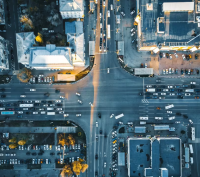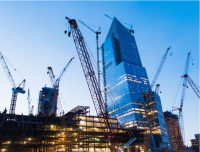
Private assets are on the cusp of a new era driven by seismic global themes. But which private asset classes are best positioned to benefit?
The flow of liquidity in private markets has shifted dramatically over the past 18 months. Geopolitical and economic tumult has ended a long phase in which investors have not needed to make many strategic adjustments. Interest rates and inflation were low, liquidity abundant and value chains had grown longer as a result of globalisation. But that has started to change. Investment strategies that have been successful for a long time may face new headwinds.
In the short term, fundraising in private assets has slowed dramatically from an especially robust period in 2021. As borrowing costs have risen, the environment favours those able to provide liquidity. We believe we are now entering an era we’ve labelled the “3D Reset”.
The 3D Reset is a shift in market structure. It describes how the dynamics of decarbonisation, demographics and deglobalisation are altering the shape of the investment landscape. To these three themes we can add technological advancement – specifically the artificial intelligence (AI) revolution. This is being driven by venture capital for now and will, we believe, completely reshape our lives.
Here we break down each of these themes.
1. Decarbonisation
Decarbonisation will happen at different speeds in different places. We expect decarbonisation to yield a deep, rich seam of investment opportunities for decades to come.
One of the most visible signs of decarbonisation is the evolution we are witnessing from combustion engine cars to electric cars. Indeed, decarbonisation will touch daily life in many ways, from what happens when we turn on a light, to how buildings behave around us. It comes down to how energy is produced, used, and preserved.
Energy, and its production, is transforming entirely. There are decades worth of investment still ahead of us.
The transition to renewable energy sources involves not just the development of additional renewable energy generation from new wind and solar capacity. The infrastructure needed to deliver the energy to source also requires large amounts of investment to avoid problems like “grid congestion”. It will require buildings to be overhauled to more efficiently use energy in heating, cooling and lighting our offices, shops and homes.
The push to decarbonise also means a fundamental change in how we produce and consume goods, from linear “take-use-discard” to a circular “re-cycle” economic model. The value of natural capital, and its role in preventing climate change and the associated costs, will also yield new opportunities.
2. Demographics
Demographic trends and the expected effects on investment opportunities vary greatly around the world. There are several emerging economies – foremost among them India - where populations are growing, and where the younger populations will contribute to robust economic growth in the next 20 years. India is the world’s most populous nation, with over 1.4 billion people and a median age of 29. Its favourable demographics combined with a burgeoning middle class, are set to boost domestic consumption and growth over the next decade.
This youth stands in stark contrast to the ageing demographics of most other large nations, where fertility rates are falling and life expectancy rising, leading to a top-heavy age distribution. This can cause working populations, and consequentially economic output, to fall. That said, artificial intelligence is expected to enhance productivity meaningfully in the near future, which could diminish the effect of top-heavy age distribution.
3. Deglobalisation
The Covid-19 pandemic, as well as the recent rise in geopolitical tension, have brought supply chain resilience and security to the fore. In some key sectors – most notably, semiconductors - it has prompted “nearshoring” initiatives that see supply chains being brought closer to home. We believe this will continue as the world becomes increasingly “multi-polar”.
In terms of its economic weight measured as global share of GDP, the US has been the dominant for over 50 years, but China is snapping at its heels. We expect India to follow suit and become another economic powerhouse. It has risen to become the fifth-largest economy in the world and is expected to be the third largest by 2030.
4. Technology
Artificial intelligence has moved from the conceptual to the practical, and is being used in many valuable ways, from diagnostics in healthcare to fraud prevention and data analysis. We believe we are at the cusp of the fifth industrial revolution. However, this fifth revolution differs to previous ones in how machines are being used and the pace of technological progress.
While the first four industrial revolutions were characterised by machines helping humans with “physical” labour, the artificial intelligence-led fifth wave is the first time machines are able to help humans with “cognitive” labour.
Where previous industrial revolutions took decades to create large scale impact, AI-first companies are registering that impact in months. For instance, ChatGPT took two months to reach 100 million users compared to five years for Uber to reach the same scale. At this pace of innovation, some believe that by 2040-50, the artificial intelligence boom will culminate in “technological singularity” – where a smartphone will have the same cognitive processing power as all humans on the planet combined.
A private markets slowdown
Despite the long-term trends creating tailwinds for private markets, they are currently seeing a slowdown in terms of fundraising, investment activity, and for some strategies, valuations. This slowdown is not uniform across all private asset classes, with some areas experiencing more significant corrections than others. The slowdown follows a period of strong private asset markets during the pandemic in 2020 and 2021 and is largely a return to pre-pandemic levels. However, the persistent high rate environment we are now in means some private market segments are overshooting into the other direction, creating opportunities for new investments.
Further reading
- Outlook 2024: Private assets in the age of the 3D Reset, by Nils Rode, Chief Investment Officer at Schroders Capital
- Investment Outlook 2024: Private Assets
- Investment Outlook 2024: Infrastructure Equity
- Investment Outlook 2024: Sustainability and Impact
- Investment Outlook 2024: Private Debt and Credit Alternatives
- Investment Outlook 2024: Private Equity
- Investment Outlook 2024: Real Estate







